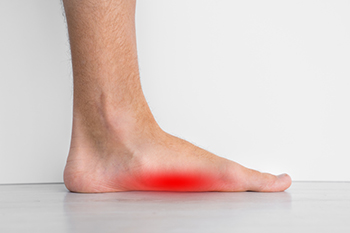Dealing with Acquired Flat Foot
Tuesday, 19 March 2024 00:00
Dealing with acquired flat feet, also known as posterior tibial tendon dysfunction, or PTTD, requires looking into its causes and symptoms. PTTD is an acquired, progressive disease of the foot and ankle that is seen commonly in middle-aged patients. When the tibialis posterior muscle or tendon weakens or stretches, it may no longer support the foot's arch. This leads to arch collapse and discomfort, including midfoot tenderness, arch pain, and ankle swelling. Symptoms may also include difficulty standing on the toes and foot weakness. Treatments involve both conservative and surgical options depending on the severity of the condition. Wearing custom foot orthotics in your shoes and immobilizing the foot in a short-leg cast or boot to allow the tendon to heal properly may be needed. In severe cases, surgery may be required. If you are experiencing symptoms that may be related to acquired flat feet, it is suggested that you make an appointment with a podiatrist today for an exam, diagnosis, and treatment options.
Flatfoot is a condition many people suffer from. If you have flat feet, contact Dr. Michael A. Wood from Foot Health Institute. Our doctor will treat your foot and ankle needs.
What Are Flat Feet?
Flatfoot is a condition in which the arch of the foot is depressed and the sole of the foot is almost completely in contact with the ground. About 20-30% of the population generally has flat feet because their arches never formed during growth.
Conditions & Problems:
Having flat feet makes it difficult to run or walk because of the stress placed on the ankles.
Alignment – The general alignment of your legs can be disrupted, because the ankles move inward which can cause major discomfort.
Knees – If you have complications with your knees, flat feet can be a contributor to arthritis in that area.
Symptoms
- Pain around the heel or arch area
- Trouble standing on the tip toe
- Swelling around the inside of the ankle
- Flat look to one or both feet
- Having your shoes feel uneven when worn
Treatment
If you are experiencing pain and stress on the foot you may weaken the posterior tibial tendon, which runs around the inside of the ankle.
If you have any questions please feel free to contact one of our offices located in Lansing, and Chicago, IL . We offer the newest diagnostic and treatment technologies for all your foot and ankle needs.




